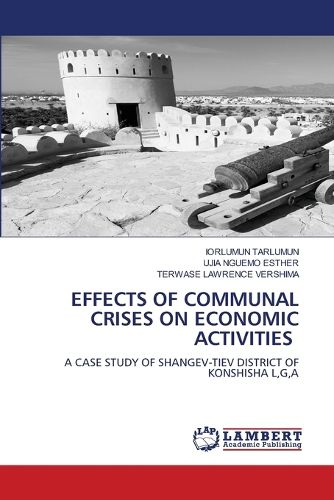Readings Newsletter
Become a Readings Member to make your shopping experience even easier.
Sign in or sign up for free!
You’re not far away from qualifying for FREE standard shipping within Australia
You’ve qualified for FREE standard shipping within Australia
The cart is loading…






This research assessed the effects of communal crises on economic activities in Shangev-Tiev district of Konshisha Local Government. Specifically, the objectives were to identify causes of communal clashes in the Shangev-Tiev district of Konshisha Local Government, assess their impact on economic activities, identify affected sectors, examine socio-economic consequences on livelihoods, and explore strategies to mitigate their impact. The study was anchored on the Frustration-Aggression Displacement Theory. The study adopted survey research methodusing a questionnaire as data gathering instrument. Sample size of 400 was determined using Taro Yamane's formula out of the estimated population of 327,000 respondents. The study used the stratified and simple random sampling techniques in selecting respondents for the study. A total of 400 questionnaires were distributed to the chosen respondents, and all of them were successfully retrieved and analyzed using frequency tables and simple percentages. According to the findings, The Shangev-Tiev district is facing communal clashes due to boundary disputes, political tussles, and cultural differences.
$9.00 standard shipping within Australia
FREE standard shipping within Australia for orders over $100.00
Express & International shipping calculated at checkout
This research assessed the effects of communal crises on economic activities in Shangev-Tiev district of Konshisha Local Government. Specifically, the objectives were to identify causes of communal clashes in the Shangev-Tiev district of Konshisha Local Government, assess their impact on economic activities, identify affected sectors, examine socio-economic consequences on livelihoods, and explore strategies to mitigate their impact. The study was anchored on the Frustration-Aggression Displacement Theory. The study adopted survey research methodusing a questionnaire as data gathering instrument. Sample size of 400 was determined using Taro Yamane's formula out of the estimated population of 327,000 respondents. The study used the stratified and simple random sampling techniques in selecting respondents for the study. A total of 400 questionnaires were distributed to the chosen respondents, and all of them were successfully retrieved and analyzed using frequency tables and simple percentages. According to the findings, The Shangev-Tiev district is facing communal clashes due to boundary disputes, political tussles, and cultural differences.